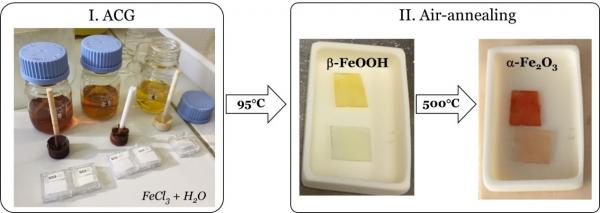


Iron oxide films elaboration by ACG at SPEC/LNO.
Left: FeCl3 solutions (pH = 1.0, 1.2, 1.4). Right: phase transition by air annealing between the akaganeite (left) and hematite (right)
The aqueous chemical growth (ACG) allows growing well-organized nanostructured oxide films with thicknesses from tens to several hundreds of nanometers. For hematite deposition the substrates (e.g. FTO on glass substrates) are dipped in aqueous FeCl3 acidic solution contained in closed bottles. The hydrothermal growth activation is achieved at temperatures lower than 100°C, the substrate being covered by an iron oxy-hydroxide film, the akaganeite phase. Film morphology, thickness, crystallographic and electronic structures, chemical composition are strongly dependent of deposition parameters: solution pH, deposition time, oven temperature, substrate cleaning, etc. Phase transition to hematite (α – Fe2O3) phase is obtained by air annealing at 500 – 600°C.
References:
https://chemrxiv.org/engage/chemrxiv/articledetails/640de8d7b5d5dbe9e825c049;
https://doi.org/10.1016/j.elspec.2023.147334
https://chemrxiv.org/engage/chemrxiv/article-details/643c03bc73c6563f14fae441
https://doi.org/10.1021/acsami.3c02131
https://doi.org/10.1039/D0TA06524B; hal-02934466
Contact CEA : Dana Stanescu from SPEC/LNO.
